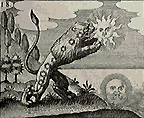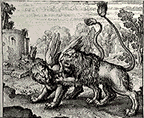Alchemy was the ancient art or pseudoscience that sought to transform base metals into silver or gold. Alchemical practice took almost identical form in ancient China, India, Egypt, and Greece, and philosophers from these cultures applied the theory of transformative elements to an esoteric spirituality: just as lead can be turned into gold, so too can the human soul achieve a perfect state.
In time alchemy degenerated into superstition, but it was revived by the Arabs in the 8th century, and reached Western Europe during the Middle Ages before being replaced by modern chemistry. The philosophy and art of alchemy, however, have inspired interest in more recent times. Psychiatrist C. G. Jung and others have written volumes of psychoanalytic interpretations of alchemical symbolism.
While not directly related to antlions, alchemy's symbolism of transformation—whether physical or spiritual—often incorporated animal imagery, and could be seen as an analogue to metamorphosis. For example, at least one medieval alchemical text uses the lion to illustrate stages of transformation, and even depicts a lioness in a winged form. Jung and others have said these lions represent primitive, and often turbulent, psychological states in the human life cycle.
Below are selected comments from Jung, Marie-Louise von Franz, and Johannes Fabricius regarding medieval depictions of the alchemical lion, with illustrations from Fabricius's book Alchemy: The Medieval Alchemists and Their Royal Art.
C. G. Jung:
In alchemy the lion, the "royal" beast, is a synonym for Mercurius, or, to be more accurate, for a stage in his transformation. He is the warm-blooded form of the devouring, predatory monster who first appears as the dragon. Usually the lion-form succeeds the dragon's death and eventual dismemberment (Fabricius 1976, p. 295).
Johannes Fabricius: [quoting Peter Blos] "The adolescent tries to come into emotional contact with the passions of his infancy and early childhood, in order for them to surrender their original [energies. . .] The profoundest and most unique quality of adolescence lies in its capacity to move between regressive and progressive consciousness." This alternation of the adolescent psyche—reviving the Oedipus complex and repressing it, conjuring up the attachment to primary love and hate objects and disengaging from them—corresponds with the alchemists' experience of the ebb and flow of their prima materia. The modern understanding of adolescence as a formative phase of extreme instability and fluidity explains the deep sea swell of the prima materia, or the unconscious, at the opening stage of the opus individuationis (Fabricius 1976, p. 29)
Marie-Louise von Franz:
The alchemical "green lion" devouring the sun relates to the experience of consciousness being overwhelmed by violent, frustrated desires (often masked by depression) (Fabricius 1976, p. 105).
C. G. Jung:
The illustrations show a furious battle between the wingless lion (red sulphur) and the winged lioness (white sulphur). The two lions are prefigurations of the royal pair, hence they wear crowns. Evidently at this stage there is still a good deal of bickering between them, and this is precisely what the fiery lion is intended to express—the passionate emotionality that precedes recognition of unconsious contents (Fabricius 1976, p. 295).
Johannes Fabricius: The two lions symbolize the king and queen, embracing in passion and hatred. This devouring union, the primal scene of a mother and father, sets the stage for a child's psychological development (Fabricius 1976, p. 48)
C. G. Jung:
The lion has among other things an unmistakable erotic aspect. Thus the "Introitus apertus" says: "Learn what the doves of Diana are, who conquer the lion with caresses; the green lion, I say, who in truth is the Babylonish dragon who kills all with his venom (Fabricius 1976, p. 298).
Marie-Louise von Franz: Some people have a frustrated infant within them. [Such] people compensate by being very correct [and polite], knowing that if they admit their demands then the devouring lion will come up and the [other person] will natually hit back, something which they have experienced often in life when, after hiding their feelings, they one day took the risk and as a result got banged on the head. So the hurt child returns once more, bitterly frustrated, and then comes the depression, the devouring lion. This is a part of primitive nature, of primitive archaic reactions which have all the conflicts of wanting to eat and not being able to do so, so that the depressive mania takes over (Fabricius 1976, p. 105-6).
Compare this final comment by von Franz to the moral of the story of the mythical "ant-lion" described in the Physiologus, an earlier Greek-Christian text:
Eliphaz the king of the Temanites said, 'The ant-lion perished because it had no food.' The Physiologus said: 'It had the face (or fore-part) of a lion and the hinder parts of an ant. Its father eats flesh, but its mother grains.' If they engender the ant-lion, they engender a thing of two natures, such that it cannot eat flesh because of the nature of its mother, nor grains because of the nature of its father. It perishes, therefore, because it has no nutriment. So is every double-minded man; unstable in all his ways. . . (Kevan 1992)
Assuming von Franz's interpretation of the alchemical lion's symbolism is correct, the similarities between these examples are remarkable: the ant-lion's inability to eat symbolizes "unstable" emotions of a "double-minded" man, while the alchemical lion—also unable to eat—symbolizes "depressive mania" (manic depression).
What could account for these similarities? How could both the medieval alchemists and the 4th century author of the Physiologus create such similarly evocative images to symbolize aspects of human psychology?
One might try to explain the similarities by pointing to cultural influence. The moral of the "ant-lion" story influenced the creators of medieval bestiaries, so it is possible that medieval alchemists were similarly influenced—by either their contemporaries or the older Physiologus.
One might also argue that the alchemical lion was independently inspired by unconscious archetypes—those inherited, structuring patterns of the psyche described by Jung, von Franz, and others. One of the claims of Jungian archetypal theory is that many of the similarities we observe in human cultural products such as religion, myth, and art (as well as behavior and personality) are due to our species' shared psychic patterns. Von Franz's interpretation of the alchemical lion, taken together with the existence of the older, similar story, might serve as evidence for an independent, archetypal origin.








